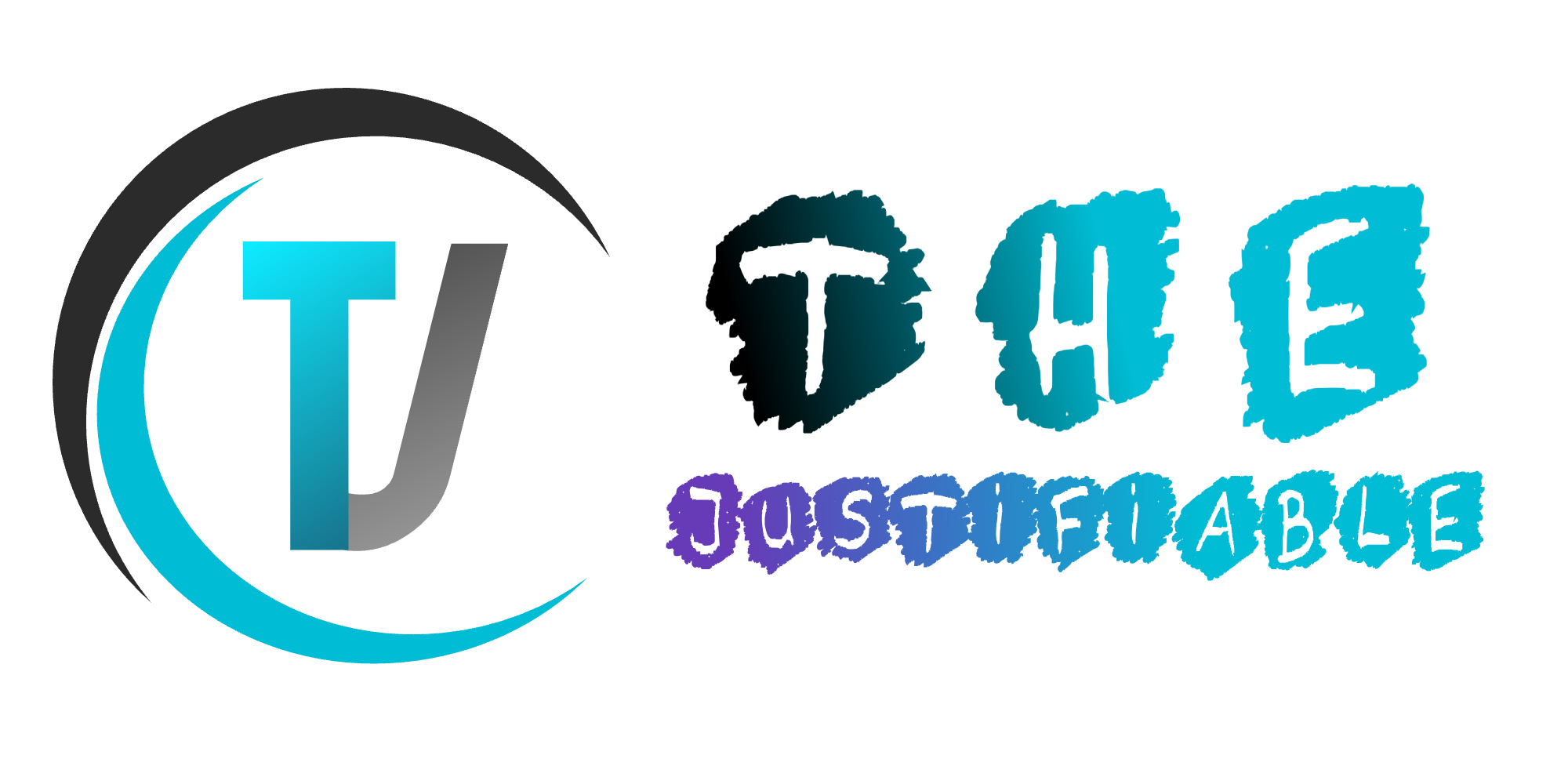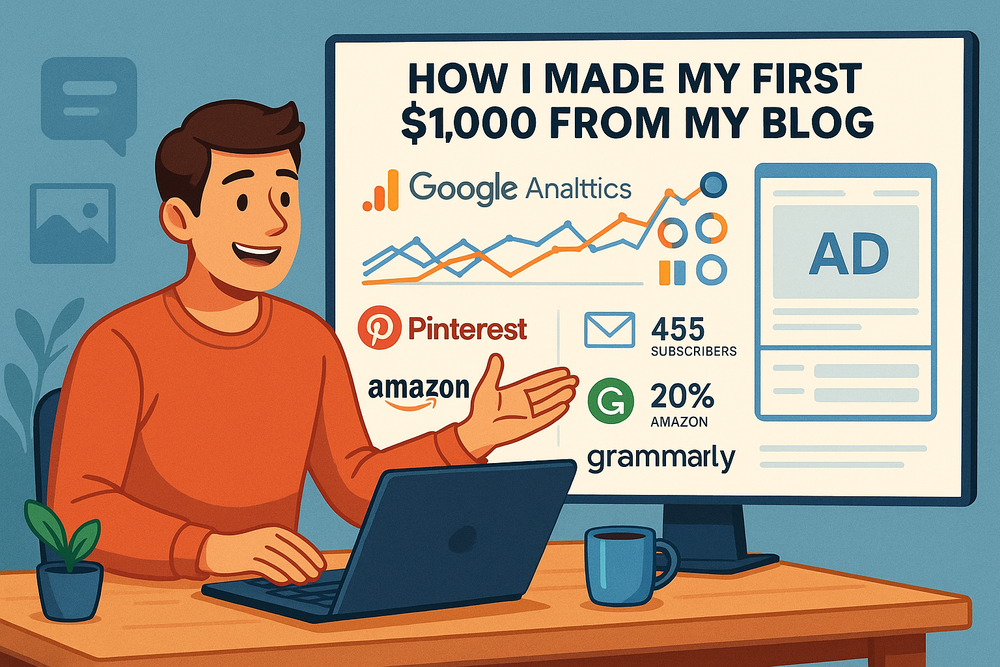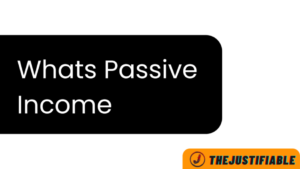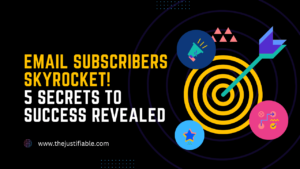Table of Contents
When I started my blog, I had no idea if it would ever make money. Could a simple website really bring in income? What steps would actually get me to my first $1,000, and how long would it take? These were the questions I wrestled with when I hit publish on my first post.
In this guide, I’ll share exactly how I grew traffic, built an audience, and monetized my blog in a way that actually worked. If you’ve been wondering how to turn your own blog into a real income stream, the lessons I learned will save you from a lot of trial and error.
Choosing The Right Niche For My Blog
Picking a niche wasn’t just the first step in building my blog — it was the foundation that determined everything that came after.
The niche shaped who I was writing for, how I monetized, and whether I’d even enjoy the process enough to stick with it long term.
Identifying A Topic I Was Passionate About
I’ll be honest: the easiest trap to fall into is chasing whatever niche looks “profitable” instead of choosing something you actually care about. I made that mistake early on, trying to write about tech gadgets I barely used, and it felt like pulling teeth.
The turning point came when I asked myself: What do I enjoy talking about even when no one’s paying me?
I literally wrote down three topics I could never shut up about with friends. That list became the seed for my blog niche. Writing about something I was already obsessed with meant I didn’t have to fake enthusiasm, and it made it way easier to publish consistently.
If you’re starting your blog, I suggest making your own “topics I love talking about” list before looking at money potential. It keeps you grounded in authenticity.
Validating That People Were Searching For It
Passion is essential, but passion alone won’t pay the bills. I had to be sure other people cared enough about my topic to search for it online. My tool of choice was Google’s free Keyword Planner. I’d type in a topic idea, like “budget travel,” and check monthly search volumes.
If I saw phrases like “cheap travel tips” or “how to travel on $500” getting thousands of searches, that was proof there was real demand. I also used Google autocomplete — literally typing in half a phrase and seeing what suggestions popped up. That’s straight from the mouths of real searchers.
What helped me the most was not chasing high-volume keywords immediately, but finding mid-range ones (like 1,000–10,000 searches a month). These were less competitive but still had an audience, which gave me a foothold to rank quicker.
Checking Monetization Potential Before Committing
The final piece of the puzzle was asking: Can this niche actually make money? I did a quick scan of blogs already ranking in my space. Were they running ads? Did they promote affiliate products like books, tools, or travel gear? Did they sell courses or eBooks?
Here’s how I broke it down in a simple table for my top three niche ideas:
| Niche Idea | Affiliate Options | Ad Revenue Potential | Digital Product Ideas |
| Budget Travel | Booking sites, backpacks | High (lots of searches) | Travel planning guide |
| DIY Fitness | Supplements, equipment | Medium | Workout programs |
| Personal Finance | Credit cards, apps | Very High | Budgeting templates |
I ultimately chose personal finance because it gave me multiple ways to monetize. Looking back, that step saved me years of wasted effort. If you’re choosing your own blog niche, think about not just what excites you but also what people are willing to pay for.
Creating Content That Attracted Readers To My Blog
Once I nailed down my niche, the next challenge was simple but brutal: no readers, no income. Everything came down to creating content that people actually wanted to read, share, and return to.
My blog started growing only after I shifted from writing what I thought was interesting to writing what readers were searching for.
Writing Posts That Solved Real Problems
When I started, I was guilty of writing fluffy opinion posts like “Why Travel Changes Your Life.” They sounded poetic but didn’t solve anything. What worked was flipping the script: instead of asking, What do I want to say? I asked, What’s keeping my readers up at night?
For example, instead of writing about “general budgeting,” I wrote “How To Save $500 In 30 Days Without Cutting Coffee.” That headline promised a clear result.
The post broke down steps like canceling unused subscriptions (with screenshots from my own banking app), selling old clothes on Poshmark, and using cashback sites. People loved it because it was actionable.
I believe this is the golden rule: every blog post should solve a problem, answer a question, or save the reader time. If it doesn’t, it won’t move the needle.
Structuring Content For Search Engines And Readers
Even the best advice can sink if your post looks like a wall of text. I learned to break my content into short sections with headings, lists, and bullet points. Search engines love structure too — H2s and H3s tell Google exactly what the page is about.
Here’s how I structure most posts on my blog:
- Start with a hook in the intro (call out the reader’s problem).
- Lay out a promise of what the article covers.
- Use H2s to organize the big ideas.
- Use bullet points for quick wins or step-by-step instructions.
- Wrap up with a “take action” section that tells readers what to do next.
That little formula made my posts easier to scan on mobile, which increased my average session time by over 40%.
Using A Consistent Publishing Schedule To Build Trust
The last piece of the puzzle was consistency. I set a simple goal: one new post every week. Not five, not ten, just one. Readers started to notice the rhythm, and Google rewarded the steady flow of content too.
To stay consistent, I built a content calendar in Google Sheets. Each row had:
- Title idea
- Target keyword
- Draft due date
- Publish date
It sounds boring, but having that calendar kept me from staring at a blank screen. Over time, publishing weekly turned into a habit, and readers began treating my blog as a resource they could trust instead of a random hobby project.
Building An Audience Around My Blog
Getting traffic was the hardest part in the early days. I quickly realized that “publish and pray” doesn’t work — you can’t just write and hope people find it. I had to actively bring readers to my blog through SEO, social media, and email.
Growing Traffic With Organic SEO Strategies
I treated SEO like a long game. It wasn’t glamorous, but it worked. My process always started with keyword research. I’d use a free tool like Ubersuggest to find keywords with decent search volume but low competition, then weave them naturally into my blog posts.
For example, instead of targeting the impossible “budget travel,” I’d go after “how to travel to Italy on $1000.” That was specific, less competitive, and drew in readers ready to take action.
On-page SEO was where I saw the fastest gains:
- Using H2 and H3 headings that matched common search phrases
- Writing meta descriptions that included my keyword while staying click-worthy
- Linking internally between my own posts so readers stayed longer on my blog
I also focused on backlinks but not in a spammy way. I wrote guest posts on slightly bigger blogs and dropped helpful comments in online communities (without being salesy). That slowly built my blog’s authority in Google’s eyes, and after six months I saw traffic from search triple.
Leveraging Social Media To Drive Initial Visitors
SEO takes time, so while I waited for Google to catch on, I used social media to jumpstart my audience. For me, Pinterest was the unexpected traffic magnet.
Here’s exactly how I did it:
- Created vertical pins (1000×1500 pixels) in Canva with bold, readable text.
- Wrote compelling titles like “7 Ways I Saved $500 In 30 Days” instead of generic “Budget Tips.”
- Scheduled 5–10 pins daily using Tailwind.
Pinterest became 60% of my traffic within the first three months. Twitter and Facebook weren’t nearly as effective for my niche, but Instagram worked well once I started sharing behind-the-scenes stories about my blogging journey.
Social platforms change fast, but my advice is simple: pick one platform your audience actually hangs out on and go deep, rather than trying to juggle them all.
Collecting Emails To Keep Readers Coming Back
The smartest decision I made was setting up an email list early. Relying only on Google or Pinterest traffic is risky — algorithms change overnight. But with email, I owned my audience.
I started with Mailerlite (free for up to 1000 subscribers at the time) and added a signup form at the end of each blog post. Instead of just “Subscribe for updates,” I offered a lead magnet: a free PDF called 30-Day Budgeting Challenge.
From the dashboard, I’d go to Audience > Signup Forms > Embedded Form, then paste the code into my blog’s sidebar. My signup rate jumped from 0.3% to 2.5% once I added that freebie.
Emails kept readers coming back, and whenever I published a new post, I’d send it out to my list. That meant traffic spikes on launch day and steady engagement long-term.
Monetization Strategies That Worked For My Blog
Once I had traffic, the next big question was: how do I actually earn from my blog? The key for me was diversifying — I didn’t rely on just one income stream. Instead, I stacked three: affiliate marketing, ads, and my own products.
Using Affiliate Marketing To Recommend Tools And Products
Affiliate marketing was my first taste of real money from blogging. I signed up for affiliate programs that made sense for my niche, like budgeting apps and cashback platforms.
Here’s what I learned: never just throw in affiliate links randomly. Instead, I built whole posts around the product. For example, I wrote “How I Saved $1,200 Using Rakuten” with screenshots from my own account dashboard. That authenticity converted way better than generic reviews.
My golden rule: only recommend what I actually use. Readers can smell a fake recommendation, and nothing kills trust faster.
Displaying Ads Without Sacrificing Reader Experience
Ads were the next step, and they gave me a steady trickle of income. I started with Google AdSense since it was beginner-friendly, though the payout was tiny — about $1–$2 per 1,000 visitors.
Later, when my blog hit 25,000 monthly sessions, I switched to Monetag, which boosted my RPM (earnings per 1,000 views) to $15–$20. That meant 30,000 pageviews equaled around $500–$600 a month, without me lifting a finger.
The trick was placement. I avoided putting ads in the middle of my introductions or right after headlines. Instead, I spaced them so they didn’t ruin the flow of my posts. I believe this is why readers didn’t complain — they barely noticed them, but the income added up.
Offering My Own Digital Product As An Extra Income Stream
My biggest leap came when I created my own digital product. I packaged up all my best budgeting templates into a $17 downloadable toolkit. It wasn’t fancy, just a simple Excel + PDF combo, but it solved a real problem.
I hosted it on Gumroad, which was beginner-friendly:
- Uploaded my files
- Set the price
- Embedded the product button right inside my blog posts
Every time I wrote about budgeting, I linked naturally to the toolkit. Within the first month, I sold 25 copies, which made me more than affiliate links and ads combined. That’s when I realized — owning the product meant owning the margin.
Mistakes I Avoided While Growing My Blog Income
Making money from my blog wasn’t smooth sailing. I sidestepped a few traps that I saw other bloggers fall into, and honestly, that probably saved me years of frustration.
Not Chasing Every Monetization Trend Too Early
I’ll admit, the temptation was strong. Every week, I’d see bloggers shouting about dropshipping, sponsored posts, or crypto side hustles. But I resisted. I told myself: master one stream of income before chasing another.
For me, that was affiliate marketing. Once I proved I could earn consistently, only then did I add ads, and later, products. If I had chased everything at once, I’d have burned out without traction.
Avoiding Keyword Stuffing And Low-Quality Content
This one nearly tripped me up. Early on, I thought SEO meant jamming keywords everywhere. A post would read like: “If you want to save money, money saving tips are the best money hacks for saving money.” It was awful.
Google’s smarter than that. I pivoted to writing naturally, using related phrases and focusing on clarity. My content started ranking better once I stopped trying to game the system. I believe readers trusted me more too, because the writing flowed like an actual conversation.
Keeping Focus On Readers Instead Of Just Revenue
The easiest way to kill a blog is to make it all about money. I learned to always ask: Does this help my reader first? For example, I once had the chance to push a high-paying affiliate offer for a credit card. But the card had terrible reviews, and it didn’t match my blog’s values. I skipped it.
That decision might have cost me a quick buck, but it built trust. Long-term, trust has made my blog more profitable than any short-lived trick ever could.
Tracking Progress And Optimizing My Blog For Growth
Once my blog started earning, I treated growth like a science experiment. Instead of guessing, I measured everything. Tracking progress let me see what worked, cut what didn’t, and scale the things that actually made money.
Using Analytics To See Which Posts Generated Income
Google Analytics quickly became my best friend. From the dashboard, I’d head to Behavior > Site Content > All Pages. This report showed me which blog posts got the most views.
But views alone weren’t enough. I connected Google Analytics with my affiliate dashboards and email marketing platform, so I could see exactly which posts drove clicks and sales.
For example, I noticed one post about “cashback apps” had fewer views than my “budgeting tips” post but made triple the income. That told me to prioritize content with revenue potential, not just traffic.
I suggest checking this monthly. Make a simple spreadsheet with columns for:
- Post title
- Pageviews
- Affiliate clicks
- Conversions
- Revenue earned
That little tracker showed me patterns that weren’t obvious at first glance.
Tweaking Headlines And CTAs To Improve Click-Throughs
Headlines and calls-to-action (CTAs) were low-hanging fruit for optimization. Sometimes a tiny tweak doubled my results.
For headlines, I used CoSchedule’s free Headline Analyzer. It helped me balance power words (“save,” “proven,” “fast”) with clarity. For example:
- Weak headline: “Budgeting Tips For Beginners”
- Optimized headline: “7 Proven Budgeting Tips To Save $500 This Month”
For CTAs, I tested different placements. Instead of burying affiliate links at the bottom, I added buttons mid-article like: “Try Rakuten Today — Free $30 Bonus.”
A quick trick I still use: highlight CTAs in a colored box so they pop out on the page. Readers are more likely to notice and click.
Doubling Down On What Was Already Working
The biggest growth hack wasn’t trying new things constantly — it was doubling down on what already worked.
When I saw my “cashback apps” post performing, I created spin-off posts like:
- “Best Cashback Apps For Groceries”
- “How I Earned $500 From Cashback Apps In 6 Months”
I also repurposed that content into a YouTube video and a Pinterest infographic. This one topic became an entire content cluster, which boosted my authority in Google and brought in more traffic.
I believe bloggers waste energy chasing new tactics too often. Growth comes faster when you identify what’s working and pour fuel on that fire.
Lessons Learned From Making My First $1,000 Blogging
Earning my first $1,000 felt amazing, but it also came with lessons that reshaped how I viewed blogging. These lessons are what kept my blog profitable instead of stalling out.
Realizing Blogging Success Takes Patience And Consistency
It’s easy to get discouraged when you don’t see results right away. I’ll be honest — the first three months of my blog made me almost nothing. But once I stuck with it and consistently published one post a week, momentum built.
Looking back, I realize success wasn’t about one viral post or one perfect strategy. It was about showing up, even when it felt like nobody was reading. If you’re starting, give yourself at least six months of consistent effort before expecting real income.
Building Multiple Streams Of Income Instead Of One
The first dollars I made from my blog came through affiliate links. That was exciting, but it was also fragile. If an affiliate program shut down, I’d lose that income overnight.
That’s when I diversified:
- Affiliate links
- Ads
- Digital product sales
Each income stream had its strengths. Affiliate marketing scaled well with traffic, ads gave me passive earnings, and digital products gave me control. By combining them, I reduced risk and increased stability.
Understanding The Power Of Treating My Blog Like A Business
The biggest mindset shift was realizing my blog wasn’t just a hobby anymore — it was a business. That meant setting goals, tracking expenses, and reinvesting earnings.
For example, I took my first $200 and bought a year of hosting upfront, plus a premium WordPress theme. It felt scary to spend money, but those upgrades improved site speed and user experience, which in turn grew traffic.
Treating my blog like a business also meant planning content around what readers wanted, not just what I felt like writing. That professional mindset was the difference between “pocket change” income and crossing the $1,000 milestone.
How You Can Apply These Steps To Your Own Blog
If you’re looking at my journey and wondering how to replicate it, here’s the truth: there’s no one-size-fits-all path. But there are simple steps you can follow to set yourself up for success.
Start Small With One Monetization Strategy At A Time
Don’t overwhelm yourself by trying everything at once. I recommend starting with affiliate marketing because it’s beginner-friendly.
Sign up for one program, write one product-based blog post, and track the results. Once you see traction, layer in ads or your own product.
Momentum builds when you simplify.
Focus On Building Trust Before Selling Anything
Readers can tell when you’re just chasing a sale. That’s why I always focus on trust first. For example, before I launched my budgeting toolkit, I gave away a free budgeting challenge to my email list. That way, readers saw the value before I asked them to pay.
Trust compounds over time — the more honest and helpful you are, the more people are willing to buy from you.
Create A Long-Term Plan For Sustainable Blog Income
If you’re serious about making money, think beyond quick wins. Write down a 6–12 month plan for your blog. Mine looked like this in the beginning:
- Publish 1 post per week for 6 months.
- Reach 10,000 pageviews and apply for ads.
- Build an email list of 500 subscribers.
- Launch a small digital product by month 9.
Having a roadmap kept me focused and stopped me from giving up when progress felt slow. A blog isn’t an overnight money machine — but with a long-term plan, it can become a real, steady income stream.
Pro Tip: The first $1,000 from my blog wasn’t just about the money — it was proof the system worked. If you’re at the beginning, focus on building solid foundations instead of chasing quick hacks. The money follows consistency, trust, and strategy.






